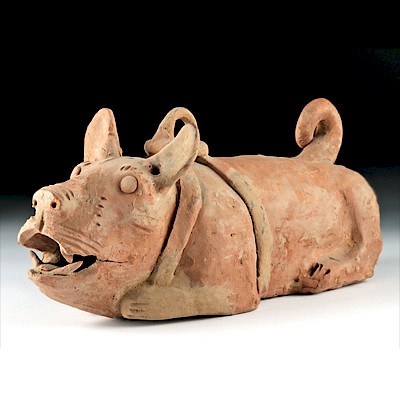Mayan Volcanic Stone Hacha - Head w/ Bird
Lot 83b
About Seller
Artemis Fine Arts
686 S Taylor Ave, Ste 106
Louisville, CO 80027
United States
Selling antiquities, ancient and ethnographic art online since 1993, Artemis Gallery specializes in Classical Antiquities (Egyptian, Greek, Roman, Near Eastern), Asian, Pre-Columbian, African / Tribal / Oceanographic art. Our extensive inventory includes pottery, stone, metal, wood, glass and textil...Read more
Estimate:
$900 - $1,400
Absentee vs Live bid
Two ways to bid:
- Leave a max absentee bid and the platform will bid on your behalf up to your maximum bid during the live auction.
- Bid live during the auction and your bids will be submitted real-time to the auctioneer.
Bid Increments
| Price | Bid Increment |
|---|---|
| $0 | $25 |
| $300 | $50 |
| $1,000 | $100 |
| $2,000 | $250 |
| $5,000 | $500 |
| $10,000 | $1,000 |
| $20,000 | $2,500 |
| $50,000 | $5,000 |
| $100,000 | $10,000 |
| $200,000 | $20,000 |
About Auction
By Artemis Fine Arts
Sep 13, 2018
Set Reminder
2018-09-13 10:00:00
2018-09-13 10:00:00
America/New_York
Bidsquare
Bidsquare : Ancient | Asian | Ethnographic - Fall Variety
https://www.bidsquare.com/auctions/artemis-gallery/ancient-asian-ethnographic---fall-variety-3432
Travel the world and back in time... Antiquities from Egypt, Greece, Italy and the Near East, Asian, Pre-Columbian, African / Tribal / Oceanic, Native American, Spanish Colonial, Russian Icons, Fine Art, much more! Artemis Fine Arts info@artemisfinearts.com
Travel the world and back in time... Antiquities from Egypt, Greece, Italy and the Near East, Asian, Pre-Columbian, African / Tribal / Oceanic, Native American, Spanish Colonial, Russian Icons, Fine Art, much more! Artemis Fine Arts info@artemisfinearts.com
- Lot Description
Pre-Columbian, Classic Maya, ca. 300 to 900 CE. A fabulous example of a figural hacha hewn from a large piece of volcanic rock, in the form of a human head wearing a parrot headdress - note the avian creature's wide-opened eyes and large curved beak. As an hacha, this piece was a ritual item associated with the Mesoamerican ballgame. The stone is of a generally flat form in order to resemble a symbolic axe - hence the name "hacha," meaning "axe" in Spanish. Beyond this, a profile visage is skillfully carved on both sides with bold features in relief including large oval eyes with sunken centers, a pronounced nose, sizeable ears, and a mouth comprised of fleshy lips. The bird headdress references the Mayan sky world. Birds were revered as sky animals associated with the celestial realm - the sun, the moon, and Venus - where they acted as sacred messengers between humankind and its deities. Size: 7.375" H (18.7 cm); 8.125" H (20.6 cm) on included custom stand.
In addition, according to Pre-Columbian mythology, each of the thirteen principal celestial deities also had a winged disguise, all of which were birds except for a butterfly.
The Mesoamerican ballgame was a ritual event, not just for entertainment (although it would have been that too!), and as a result had elaborate attire and accessories. Stone hachas were not actually used to play the game, but instead were probably worn or carried, hafted onto wooden poles like standards, in ritual processions where the elite sponsors of the game displayed them to demonstrate their wealth - a little like seeing the owners of your local team out on the field after a championship win or on Opening Day.
Provenance: private San Francisco, California, USA collection
All items legal to buy/sell under U.S. Statute covering cultural patrimony Code 2600, CHAPTER 14, and are guaranteed to be as described or your money back.
A Certificate of Authenticity will accompany all winning bids.
We ship worldwide and handle all shipping in-house for your convenience.
#138054Expected surface wear with a few nicks and abraded areas commensurate with age. Earthen and mineral deposits.Condition
- Shipping Info
-
All shipping is handled in-house for your convenience. Your invoice from Artemis Gallery will include shipping calculation instructions. If in doubt, please inquire BEFORE bidding for estimated shipping costs for individual items.
-
- Buyer's Premium



 EUR
EUR CAD
CAD AUD
AUD GBP
GBP MXN
MXN HKD
HKD CNY
CNY MYR
MYR SEK
SEK SGD
SGD CHF
CHF THB
THB














